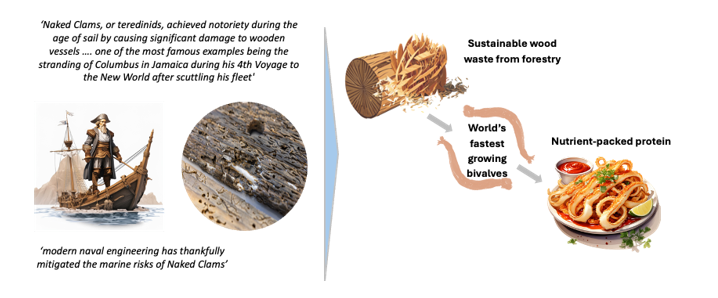NAKED CLAMS: A COMPREHENSIVE ANALYSIS OF THEIR GLOBAL POTENTIAL FOR COMMERCIAL AQUACULTURE
Introduction
Naked clam aquaculture presents a game-changing solution for sustainable seafood production, capable of transforming waste wood into highly nutritious, low-environmental-impact protein for global consumption . Our previous articles in npj Sustainable Agriculture and Food Frontiers set the stage for naked clams. We demonstrated the world’s first naked clam aquaculture system, nutritional analysis and global social media survey on their perception worldwide. This research showcased the groundbreaking potential of naked clams to turn waste wood into highly nutritious, low environmental impact protein that could feed millions of people worldwide, and captured international media attention, including coverage in the BBC, Financial Times, ITV, Sky News, and The Times, in addition to several aquaculture specific media outlets.
Approach and Results
Our work presented today is the first comprehensive global analysis of naked clam aquaculture. By synthesising distribution, growth rate and size data across 24 species, we demonstrate that naked clams grow up to 3× faster than commercially farmed blue mussels, with some species exceeding 1.5 meters in length—despite the fact that their aquaculture has yet to be scientifically optimised. Large and fast-growing species are distributed globally, offering a readily available, scalable solution to sustainable seafood production. We further consolidate existing reports on their nutritional attributes, including their high protein content, vitamin B12 levels, and potential health benefits, while identifying critical knowledge gaps requiring further research.
To support the development of a scalable, low-impact aquaculture sector, we outline a strategic roadmap addressing species selection, growth optimisation, and disease prevention, offering a clear framework for future research and commercialisation. This work not only delivers new biological insights but also positions naked clams as a high-yield, low-carbon alternative to conventional aquaculture species, offering a transformative opportunity for sustainable seafood production while fully integrating into circular economies by converting waste wood into nutrient-dense protein, thereby closing resource loops and valorizing forestry byproducts.
The team our currently working on scale-up of naked clams within an IMTA system.
